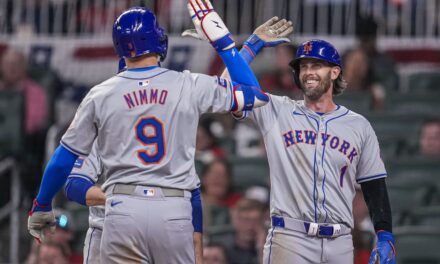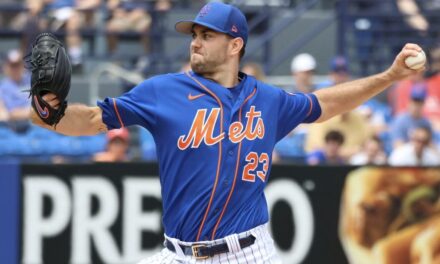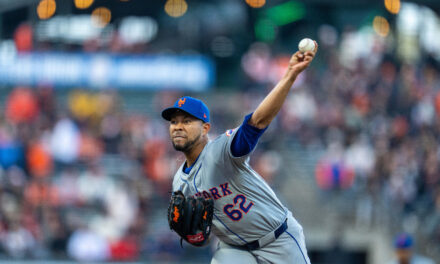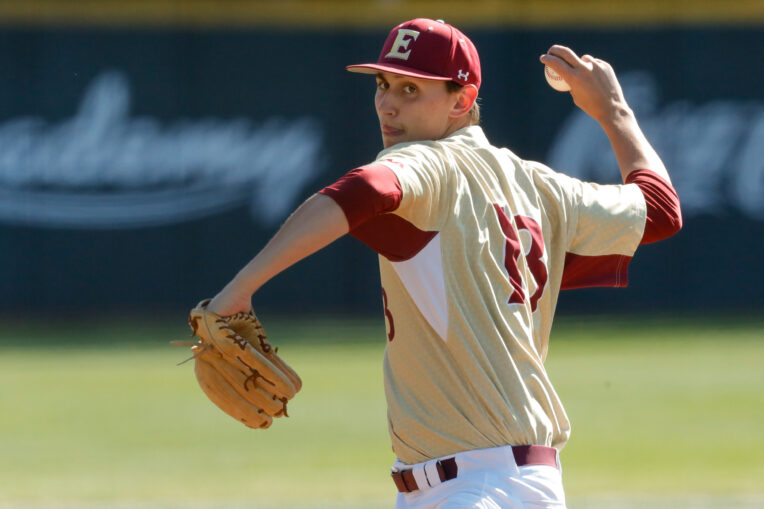
George Kirby, Photo by Elon Athletics
The 2019 MLB Draft is among us once again. It seems like just yesterday we saw the final draft of the Sandy Alderson regime, in which the Mets chose outfielder Jarred Kelenic and pitcher Simeon Woods-Richardson in the first two rounds of day one. Now, here we are, one year later, awaiting to see how the new front office of Brodie Van Wagenen will make their choices.
The first two rounds of the draft will air tonight at 7 PM out the MLB Network Studios in Secaucus, NJ. While not considered a very deep draft, there is plenty of big talent towards the top of the pool. Draft day is about unpredictable as it comes. It’s tough to be sure exactly what a given team may be thinking going into their selections, and some teams may be put on their toes when picks are taken out from under them. Some teams may want to go underslot, and some may have a player they didn’t expect to fall to them actually fall to them.
That’s what we want to talk about today. We want to try to get into the heads of the Mets front office and see how they may go about today’s first round pick, while still thinking about drafting the best player available.
The Mets will have the 12th selection in the first round today, and then the 53rd overall pick in the second round. Their bonus pool sits at $8,224,600 for the first ten rounds. Their first round pool will be set at $4,366,400, and their second round pool will be set at $1,370,400. Teams that spend over their allotted bonus pools will face certain taxes depending on how much above they will go:
0-5%: The team will pay a 75% tax on overage
5-10%: forfeiture of a future first-round pick and a 75% tax on overage
10-15%: forfeiture of a future first and second round pick and a 100% tax on overage
15%+: forfeiture of two future first-round picks, and a 100% tax on overage
For reference, 23 of 30 teams exceeded their pools last year, and no team has ever gone over 5% with these rules in place.
The Ideal Pick
Jackson Rutledge, RHP, San Jacinto (Texas) JC
We’ve spoken about Rutledge here at length before, but there is so much about the big right-hander that bears repeating. Standing at 6′ 8″, Rutledge is a big power arm with more than just a few bells and whistles. While he used to be a three-pitch pitcher with a fastball slurve, change-up combo, with the use of Rapsodo technology, Rutledge has been able to break what was a less effective slurve into two pitches. Scouts have recently said that Rutledge’s curve and slider both flash plus, to go along with an above average change-up. Rutledge also has to ability to maintain velocity deep into games.
Rutledge perhaps has the highest ceiling of any pitcher in this draft, but also is seen as a bit of a reliever risk due to previous control issues. He did still walk over three batters per nine innings this season, and that may come as a concern. Nevertheless, Rutledge still has a ridiculously high floor and should absolutely be in consideration if available at 12.
Rutledge would be a logical choice here for the Mets, but it is also possible that he would command most of his $4.366 million slot allowance. Kelenic signed for $4.5 million last year, about $1 million under what his draft slot was worth.
You can read more about Jackson Rutledge here.
The Under Slot Pick
George Kirby, RHP, Elon University
George Kirby is one of those guys who just boosted their draft stock tremendously with outstanding performance just before the draft. The big thing about Kirby is that he does not give up free passes. Holding the best K-BB ratio in college baseball at 17.83, Kirby knows how to throw strikes. This bears the question, how does a guy who throws so many strikes not get hit around? Location, location, location. That’s the name of the game for Kirby’s fastball. He can work that pitch to both sides of the plate, and paint it how he likes.
Kirby also keeps hitters off balance with three different secondary pitches. His change-up, the best of his secondary pitches, has strong downward bite, and generates plenty of swings and misses. While his curve and slider lag behind his change, his slider is seen to be improving and showing signs of being a plus pitch in the future.
While Kirby has shown excellent control, he will have to work on command of his breaking pitches as he moves up through the minor leagues. Some scouts fear that Kirby will not get the same swings and misses against stronger competition, though his brief time in the Cape Cod League, in which he held a 24-1 K-BB ratio perhaps suggests otherwise.
Kirby is ranked right around 20 on most Draft Prospect boards, and he would be taking under slot for the Mets at 12, which could possibly allow them to go over on their second-round pick, or have more space for later picks.
The Over Slot Pick
Alek Manoah, RHP, West Virginia University
Alek Manoah can be a bit divisive. Depending on who you ask, he could be looked at as the second best arm in the draft after Nick Lodolo, or he could be a top 5 arm with some concerns regarding command. All things considered, it does seem that the Mets will be taking a college arm with their first pick. The focus on college pitchers is based on what seems to be interest in the Mets front office. That said, Manoah would be an excellent choice.
Manoah has been one of the most dominant pitchers this spring. In 94 innings, over 14 starts (6.7 innings per start), Manoah held a 1.91 ERA and struck out 125 batters (11.93 K/9) and just walking 22 (2.10 BB/9).
Holding a three-pitch repertoire of a mid-high 90s fastball, a hard slider, and a solid change-up, Manoah has the makings of a solid starter. It wasn’t until he got consistent starting time in the Cape Cod League, in which he had 7 starts at a 2.70 ERA, that Manoah was seen as a full-time starting pitcher. Since then, he’s taken the reins and boosted his value into an early round pick.
Manoah is a big guy, though. Clocks in at 6′ 6″ 260 pounds, and that’s something that some teams may be weary of. His athleticism will come into question, but it wouldn’t be the first time we’ve seen a guy his size hold his own.
Video Courtesy of 20-80 Baseball
While expected to go within the top ten picks, there’s an outside chance that Manoah falls to the Mets, and in that instance, he’d be a solid get for them at 12.
Manoah’s brother Erik was taken by the Mets in the 13th round of the 2014 draft, and traded to the Angels in 2016 for reliever Fernando Salas. The younger Manoah outsizes his brother by four inches and shows much higher pedigree.
The Prep Outfielder
Corbin Carroll, OF, Lakeside (Wash.) HS
Last year, the Mets made a similar choice in taking OF Jarred Kelenic in the first round, but these are two different players. Carroll is more legs than Kelenic. The speedy outfielder stands at 5′ 10″ and 170, which may seem light, but he makes the absolute most of his frame.
Carroll has one of the most advanced approaches for a hitter his age in this draft, and has impressed scouts for his ability to take pitches, as well as drive them. He has a very balanced swing, and has strength beyond what one would imagine at first glance. While he does have some pop right now, more power is expected to come as his he grows into his frame. The bat to ball ability alongside his patience is what drives scouts to believe that there is a future in his bat.
Notably a fast runner, Carroll is a guy who uses his speed to his advantage on both sides of the ball. He’s an excellent baserunner, and he is one of this drafts best defensive center fielders. While his arm isn’t quite as strong as the rest of his game, word is that it has been improving as he continues to get stronger.
Though he has a commitment to UCLA, there should not be any concerns with signing if he is drafted this early on. Carroll has drawn comparisons to Jacoby Ellsbury and Andrew Benintendi for his frame and style of play.
Video Courtesy of Fangraphs
The Fan Service Pick
Shea Langeliers, C, Baylor University
Yes, his name is Shea. Yes, like Shea Stadium.
On a serious note, any other year, Langeliers would be the top catching draft prospect, but he had the misfortune of being in the same draft as Adley Rutschman, who almost certainly go 1-1 tonight. Langeliers broke the NCAA single game RBI record with 11, two days before the draft. He went 5-6 with three home runs, and again, with 11 RBI. Still, he will only be the second best catcher drafted on Monday night. Given who is going first, that says more about the quality of Rutschman than it does anything else, since Langeliers is excellent in his own right.
Langeliers came in hot as a freshman in Baylor and hit .313/.388/.540 over 243 plate appearances and was a unanimous selection to the Big 12 All Freshman Team, as well as making the All Big-12 Second Team. During sophomore year, he battled a wrist injury which and saw his OPS drop from .928 the year before, to .847 in 2018. Scouts believed that Langeliers was sacrificing contact for power, and it drew some concern for his draft stock. However, his performance in 2019 has more than sufficiently boosted that right back up, especially after breaking the hamate bone in his left hand earlier this spring. Hitting .311/.376/.484 during this spring definitely helped him get right back up there, but this recent performance may have put him in the top ten.
ICYMI: Shea Langeliers had a day for the ages!#RoadToOmaha | @BaylorBaseball pic.twitter.com/9xVn7VohIx
— NCAA Baseball (@NCAABaseball) June 2, 2019
All this talk about Langeliers bat almost makes one forget that he is touted as a defense-first catcher. Winner of the 2018 Rawlings/ABCA Gold Glove, Langeliers is known as a solid pitch framer, and known for having a strong arm. Gunning down 70% of would be base stealers in his sophomore year, his arm became a thing to watch for. Standing at a solid 6′ 0″ 190 pounds, Langeliers is no slouch behind the plate when it comes to blocking pitches either.
MLB.com currently has his arm at a 70 rating and his defense at 60 while also saying that his arm can “produce 1.7-second pop times in workouts and 1.8-second clockings during games.”
It’s possible that Langeliers may not even be available at 12 when the Mets pick, but it’s almost certain that he’d be a welcome addition if he is, and the Mets take him in that place. Mets fans have long been waiting for their catcher of the future, and this could be the resolution to that endless clamoring.
Honorable Mentions
Zack Thompson, LHP, Kentucky University
The lefty has often been linked to the Mets in mock drafts this spring, though there are concerns due to previous elbow injuries, and overuse this season. Thompson pitched to a 2.40 ERA in 90.1 innings for Kentucky while striking out 130 and walking 34. Definitely one of the top five arms in this draft, even with injury concerns, he would be a solid pick for the Mets.
Bryson Stott, SS, University of Nevada Las Vegas
Stott has been linked to the Mets this spring, as well. Riding similar helium to that of Jonathan India just last year, Stott has shown an improved approach, which also hitting for more power this season. While he might be a third baseman in the future, he has solid instincts that could lead to him sticking at short. Stott also has a strong arm that has been clocked at 97 MPH across the diamond. Stott hit .356/.486/.599 in 281 plate appearances this season. I wrote more about Bryson Stott here.
Josh Jung, 3B, Texas Tech University
Perhaps taking Jung at 12 would be a reach for the Mets, but Jung has been one of the most consistent offensive producers over the last couple of years. Jung shows good power and contact ability hitting .333/.471/.597 this year, but the concern is that he may be giving away more of his power for some contact, especially after he hit .392/.491/.639 as a sophomore.
Walking more times than he struck out, 46 walks to 34 strikeouts, Jung has one of the better approaches at the plate. His defense, however, has a number of question marks. Jung played shortstop for the Red Raiders and showed good instincts, but almost positively making the move to third. Even with good instincts and a strong arm, some scouts believe that Jung may eventually have to move to the corner outfield or even first base.
While the questions exist on his defense, his bat certainly plays, and the Mets could do much worse at the 12th pick in the draft.
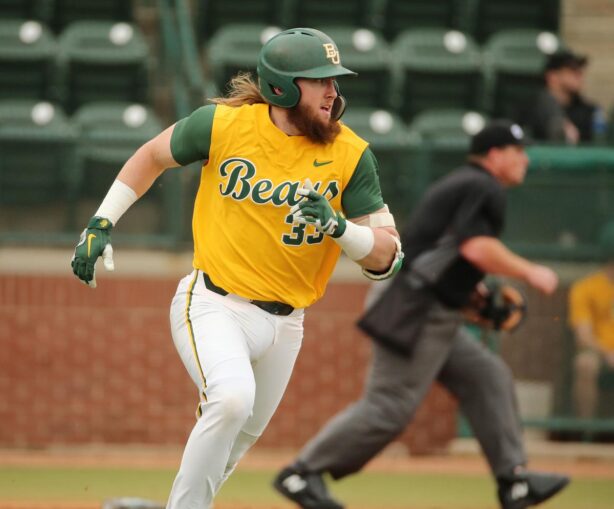
Photo by Rod Aydelotte, Waco Tribune
Second Round: Davis Wendzel, 3B, Baylor University
Fangraphs recently mocked the Mets taking Florida Shortstop Brady McConnell in the second round with the 53rd pick. McConnell is a very toolsy player, with a load of talent, but I can see the Mets taking more offensive approach in the second round. Similar to when they took Pete Alonso in the second round of the 2016 draft, I can see them taking a quick moving bat like Wendzel in the second round this year.
Wendzel, a former high school teammate of top prospect Royce Lewis, and current teammate of Shea Langeliers, has been one of the most consistent offensive producers since he struck the scene back in 2017.
Wendzel hit .385/.500/.647 this season and is a very disciplined hitter. Defensively, Wendzel is considered very reliable. He has solid defense and true arm at third base. Perhaps what is keeping Wendzel out of the first round is his lack of speed and a swing that can tend to get long and fall behind pitches.
If available at 53, this would be a move the Mets should definitely make for what the bat and glove bring in future value.


